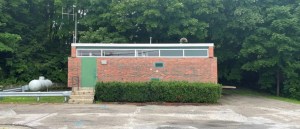
Voters in Yarmouth will decide on a $10.5 million bond question during the Nov. 5 election. The money would cover the costs of three infrastructure projects that town officials have deemed critical, including rehabbing the Harbor Pump Station. Contributed / Town of Yarmouth
Yarmouth voters will weigh on a ballot question on Nov. 5 to fund three infrastructure projects that Town Manager Scott LaFlamme has called “critical” and needed as opposed to a “want.”
The Yarmouth Town Council voted unanimously on Sept. 5 to approve a $10.5 million bond authorization request that – if voted through – would cover rehabbing the Harbor Pump Station; replacing the Davis Landing Bridge; and fixing up the Cousin’s Island walkway.
About $7 million would go toward upgrading the Harbor Pump Station, which is located on Route 88. The Harbor Pump Station is the largest of the town’s some 30 pump stations. It was constructed in 1967 and outfitted with new pumps in 1992. It handles 85% of the town’s sewer flow but is no longer up to code and requires significant repairs, according to town materials.
The Harbor Pump Station is also the only facility that can remove grit – inorganic matter that needs to be removed manually – from the sewer flow system wide. The current grit removal function is old and does not work efficiently, according to the town. With the help of an outside engineering firm, the town wants to pursue an option that transfers the town’s grit removal system to its wastewater plant on Whitcombs Way, and updates the Harbor Pump Station.
This will provide more efficient grit removal for 100% of the flow and will greatly simplify grit handling and transportation,” according to an August presentation from Yarmouth’s town engineer, Steven Johnson.
Of the total bond amount, $1.5 million would be used to replace Davis Landing Bridge — a concrete structure built in 1936 that carries East Main Street traffic over Pratt’s Brook. Because the bridge is less than 20 feet in length, it is owned by the town, not the state.
The Maine Department of Transportation last inspected the bridge in 2023 and determined that parts of it are in “serious” condition, according to the town. With the help of an outside consulting firm, the town worked with MDOT, the Army Corps of Engineers and the U.S. Coast Guard to come up with a plan to replace the existing bridge with a precast concrete arch structure and headwall.
The last project included in the bond, the renovation of the walkway, is expected to cost $2 million. The well-trafficked pedestrian walkway, which stretches along Cousin’s Street from Sandy Point Beach to Wharf Road, does not currently meet Americans with Disabilities Act requirements.
At the Sept. 5 special meeting to discuss the bond, only one member of the public weighed in. Mike Tremblay, the vice chair of the Yarmouth Bike and Pedestrian Committee said that his committee has discussed the need for fixing the Cousin’s Island walkway.
“Personally, I believe all the three of these projects seem very worthwhile and needed,” he said.
The town is proposing a 25-year term for the bond, according to Town Manager Scott LaFlamme. Staff are factoring in a “conservative” 4% interest rate when projecting how much the town will owe.
“Given our bond rating, we suspect that the interest rate would be lower than 4%, but this is consistent with what other communities are seeing from lenders,” LaFlamme wrote in a follow up email to the Forecaster.
In a most-expensive case scenario, the town could expect to pay $830,000 in principal and interest for these projects in FY 2026, according to LaFlamme’s presentation. This would equate to an additional 48 cents on the mil rate, or an additional $240 for homeowners with a house assessed at $500,000, said the finance director toward the end of the meeting.
In a more optimistic prediction, the town estimates that they could pay zero for the new projects in FY ’26 and pay $420,000 in interest in FY ’27, depending on when the bonds are released to the market and if the town uses a bond anticipation note for design and engineering, according to LaFlamme.
He emphasized during the presentation that all the projections are preliminary.
LaFlamme said that the town has been looking at some alternative funding sources, such as Building Resilient Infrastructure and Communities grant funds, and moving around money internally, like using tax increment financing funds to pay for some of the annual debt service obligation, in order to offset the impact to taxpayers.
In an interview prior to the vote on Sept. 5, LaFlamme acknowledged that it has been a tough year for taxes.
At the June 4 Town Meeting, residents approved a $58.8 million town-school budget that would increase taxes roughly 9% for fiscal year 2025.
“Tax increases are not ever liked,” he said. “We are continuing to refine our budgeting process, and we know that that 9% is not sustainable. We are committed to really focusing on working with the school committee … leading up to next year’s budget conversation.”
But he emphasized that the projects outlined by the town engineer were not something that could be pushed off. “Again, these projects are not a wish list.”
